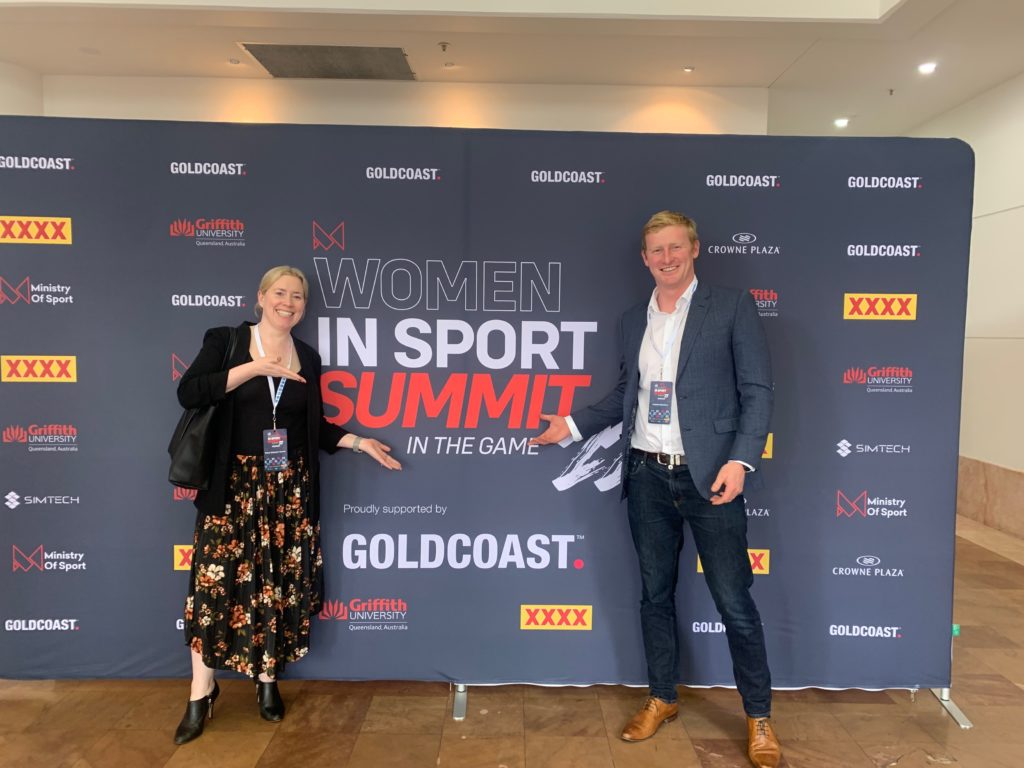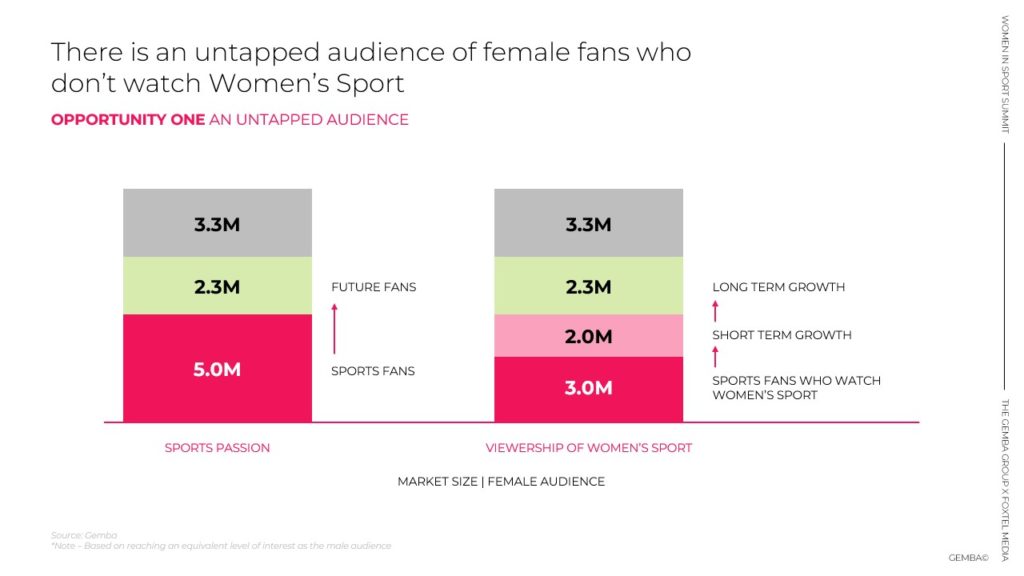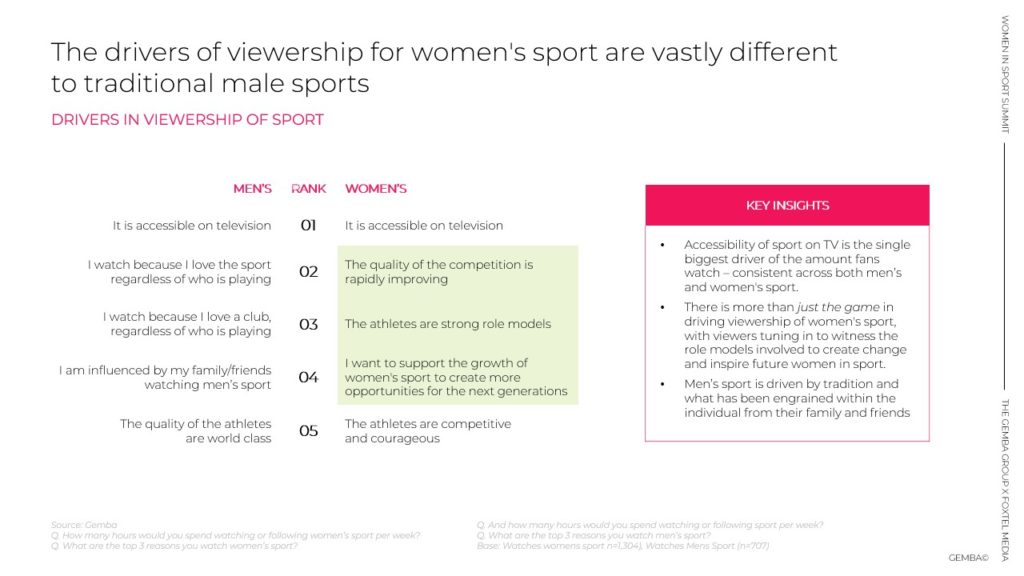It was great to be back at a live conference after the virtual and hybrid alternatives of recent years. Ministry Of Sport’s Women In Sport Summit didn’t disappoint, with a massive agenda, jam-packed with interesting people and presentations – from the energy of Angel City FC’s Stephanie Rudnick to the humility of UFC fighters Valentina “Bullet” Shevchenko and Joanna “JJ” Jedrzejczyk to the spontaneity of Aussie Olympian Natalie Cook.
Even some minor tech issues, a slightly disconcerting artificial intelligence MC, and an ill-timed fire alarm weren’t enough to dampen the audience’s enthusiasm for a day devoted entirely to women’s sport.

Here are my four key take aways from the fifteen (of twenty-three) presentations I saw:
1. The untapped potential of women’s sport is HUGE
Gemba and Foxtel Media’s Shifting the Goal Posts research identified a short-term opportunity to convert two million Australians who don’t currently watch or attend women’s sports (but are interested in major men’s leagues) into women’s sports viewers.

FIFA Women’s World Cup 2023 COO’s Jane Fernandez and Jane Patterson cited the unprecedented coverage of women’s football in 2022 as an indicator of what the future holds. FIFA expects the fanbase to double over the next decade, and are forecasting a six-time increase in the commercial value of women’s football by 2032.
Perhaps it was because of the audience (mostly women, mostly working in sport) or the summit topic, but refreshingly none of the presenters felt the need to cover why women’s sport matters. The economic and social benefits were taken as read. There was, however, a focus on how to capitalise on the huge untapped potential of women’s sport.
2. Female athletes are strong role models who need more visibility
Gemba’s research highlighted that while viewership of male sports is driven by team popularity and accessibility, one of the key drivers for women’s sport is female athletes’ stories and strength as role models.
This was aligned with one of the statistics presented by Jane Fernandez, that 33% of women’s football fans cite ‘players as good role models’ as a reason for following the sport.
That old adage – and the most used expression of the day – “you can’t be what you can’t see” holds true. The need for visibility is not new news (I wrote about it two years ago here), but it continues to matter.
It was great to see the conference providing visibility by putting athletes front and centre throughout the day. Panels included Angel City FC Captain Ali Riley, pro golfer Cassie Porter, AFLW player Chloe Molloy (who I’ve loved since we shot this piece of content with her in 2018), and former ironwoman Bonnie Hancock, to name but a few.
Angel City FC shared how they were addressing visibility, by ensuring all athletes’ media profiles were invested in, not just those who are already big names.
UFC work collaboratively with brands to raise the profile of their athletes and they don’t media train them, preferring them to be as authentic as possible. If Joanna and Valentina were anything to go by, that strategy is paying off. Both were inspiring, articulate and positive, urging the audience to “put your heart and power into fulfilling your dreams”.
Not only do female athletes need the spotlight, they want and deserve it. As Cassie Porter implored the audience,
“Put us on the same stage as the men”.
3. Broadcast and social media can provide the spotlight needed
Gemba’s report found that the biggest driver of viewership for women’s sport is accessibility on television. Australians’ future hopes for broadcast are that women’s sport is more accessible than ever, the quality of coverage continues to improve and that there is a greater representation of women in all areas of the game (eg commentary).

Many of the speakers covered the importance of broadcast support, with Kayo Sports’ Marketing Director, Kim McConnie, noting that “we are seeing the numbers stack up” with a massive summer of women’s sport ahead. An early indicator of this momentum has been AFLW and NRLW viewership with uplifts of 40% and 75% respectively season on season.
Whilst broadcast reach has always been important, increasingly social media is playing a more significant role in spotlighting our female athletes.
One of the factors that UFC Vice President Australia & New Zealand, Peter Kloczko attributed to the success of mixed martial arts and the profile of its athletes was their early adoption of social media. UFC had 26 billion video views last year across all digital platforms.
TikTok’s Growth Strategy Lead, Elle Batchelor, made her case for the platform saying it has “re-engineered the value equation for women in sport”. Batchelor noted that every athlete in every sport can use TikTok to grow their presence, by tapping into the existing fandom on the platform to showcase their personalities and engage with a passionate audience. She called out the 293 million views #samkerr has on the platform, without even being on it herself!
4. We need to be audacious
Many of the organisations in attendance were looking to the future and aspiring to do more.
Jane and Jane want to ensure that next year’s FIFA Women’s World Cup has the same legacy in Australia and New Zealand that the Sydney Olympics had… “while women’s sport has the spotlight, we need to use it.”
Netball Australia’s CEO, Kelly Ryan, called out their goal for netball to become an Olympic sport by 2032.
Sarah Styles, Director at the Office for Women in Sport and Recreation, asked us to seriously consider what we want the future for women’s sport to look like in 2032. We risk being in the same position in ten years’ time “if we aren’t deliberate, purposeful and bold in our actions”.
It was Netball Australia’s vision that struck a chord for me and best summed up the sentiment I left the day with –
“our brightest moments, greatest achievements and best stories are still ahead of us”.